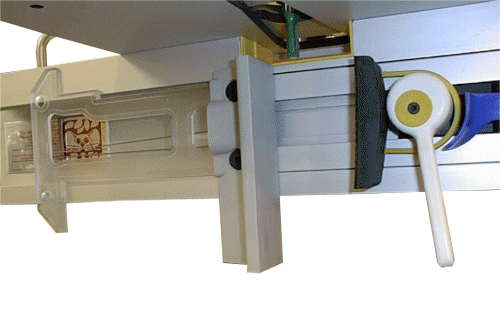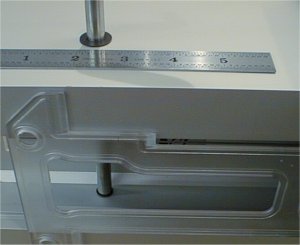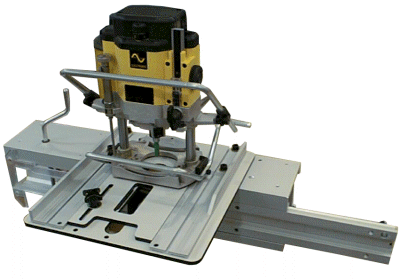|
|
|
Back to the LittleRat Index Page
|
| Impressions The LittleRat is a smaller version of the WoodRat. The LittleRat looks unconventional but like a few other jigs and tools, it's unusual looks belie its fundamental simplicity. The main principles behind making joints with the LittleRat is that you can: A. Index the cutter from an initial reference point. B. Control the cutter in the XY&Z axis. C. Use the climb cut technique for smooth cuts with no tear-out. |
| Assembly The LittleRat ships in a tightly packed box along with any accessories that might be ordered along-with. All the parts are protected and small items are separated into plastic bags. There isn't much assembly involved with the LittleRat, a couple of glances at the instructions are all that's needed for proper assembly. Metric Allen wrenches are supplied for the bolts. The LittleRat must be secured or mounted in order to be used. It is possible to clamp the tool to the workbench but the preferred method would be to mount it to a wall. A cleat hanger is described in the manual for doing just this. While I'm sure that method would work just fine, I would prefer to bolt it to the wall. A thick spiral bound, shop-worthy manual is supplied with the jig. Overall the manual is good and describes how to make all the common joints with the jig. The manual is supplemented with some on-line addendum's and such via the WoodRat web site as well. Due to the tool's uniqueness, the manual should be studied a bit before attempting any complex joints. |
| Operation Unlike its bigger brother the WoodRat, the LittleRat uses a pointer to position for a cut. This, along with the size and the WoodRat's ability to use different degree dovetail angles are the major differences between the two jigs. I initially thought the single clamp design would be a short coming compared to the larger WoodRat. I'm now of the opinion that this (for me anyway) is the more desirable of the two positioning methods. Instead of lining up a drawn image of the joint, one simply lines up the cursor with a drawn line. It should be noted that this only applies to the power feeding aspect, not the "pull" or "Y" axis movement. |
 |
| Once one gains a little familiarity with the tool, its operation becomes fairly straightforward. Basically, one clamps the work piece up and moves it and the router in an XY manner until the joint is complete. Positioning is controlled by lining up the cursor with marks made on the tool or with marks on the work piece itself. It's actually very simple. | |
 |
This is the "cursor" used by the LittleRat to position
the stock clamped to the sliding carriage. Basically all one does is position the
carriage, mark a line with a pencil directly on the extrusion against the cursor; and then
move on to the next position. Cutting is basically the same. The carriage is moved to a line and a cut is made. The carriage can be moved left or right in any sequence because there is zero backlash (very clever by the way) on the movement of the carriage. |
Joints |
|
Dovetails: Doweling / Drilling: |
|
| Dust Collection As mentioned, the preferred method for securing the tool is via a user made wall cleat. WoodRat has designed a mounting cleat that also incorporates a dust collection channel as well. There is no collection when the cutter is on the operator side of the stock (unless the user provides it), only the back side can be collected upon. From the back, very little of the shaving get thrown into the air at all. A router certainly will create a lot of shavings in this tool however it is significantly cleaner overall than a template dovetail jig even with no collection at all. |
|
| Capacity The normal stock width capacity that can be clamped with the clamp system is 17 3/8" wide; with jigs this width can be extended. The maximum joint making capacity in the Y axis is 8 inches. This means that a groove or similar joint can be made across the face of stock up to 8" wide. For typical joint this capacity is fine, for a bookcase or similar project, it is a bit small. The opening in the base plate varies from 1 ½" to a little over 1" wide. This is adequate for any operation I'd care to attempt with the jig. The total stroke (under the bit) that the sliding carriage is capable of is an inspiring 37 ½". That means (in theory) that with user-made jigs, a controlled cut can be made 37 ½" long. I haven't tested to see how straight or square the travel is. The maximum "normal" cursor capacity is 6". The extended theoretical cursor capacity using the bottom channel and a shop-made cursor (as designed by WoodRat) is 30". |
 |
Summary
In the interest of full disclosure WoodRat provided this product to facilitate this review. Another article that may be of interest is a Joint Comparison chart listing the capabilities of several jigs and machines.
|